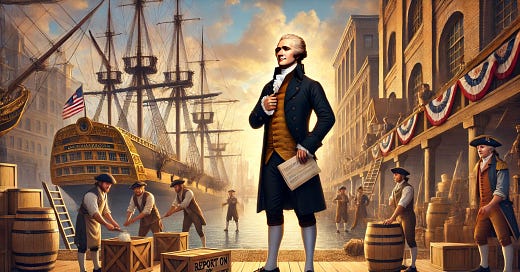Hamilton, Trump, and Tariffs in 2025
As Donald Trump prepares for his second term in 2025, his tariff strategy echoes Alexander Hamilton's economic vision for a strong America.
Can Trump’s 2025 Tariffs Reshape America Again?
Donald J. Trump is heading back to the Oval Office, and one thing is certain: tariffs will be front and center in his economic playbook. Much like Alexander Hamilton in the 1790s, Trump sees tariffs not just as taxes, but as tools to protect American workers, rebuild manufacturing, and challenge foreign competitors.
Trump’s 2025 plans look a lot like his first term: tariffs on China, steel, and other critical sectors. But will they work? To answer that, we have to go back to Alexander Hamilton’s bold ideas—and how they laid the groundwork for America’s economic independence.
Hamilton’s Tariffs: A Blueprint for Independence
When Alexander Hamilton became the first Secretary of the Treasury, he had a clear vision: build an economy that didn’t depend on foreign imports. In his 1791 “Report on Manufactures” (this is a large PDF), he argued for tariffs to fund the government and protect budding American industries.
The “Tariff of 1789” was one of Hamilton’s first big wins. It taxed imported goods, giving domestic manufacturers a fighting chance. This wasn’t just about economics—it was about national security. Hamilton knew America couldn’t call itself independent while relying on British imports.
Trump’s approach echoes this same principle: tariffs are about more than dollars and cents. They’re about sovereignty.
Trump’s Tariff Playbook for 2025
In his first term, Trump imposed sweeping tariffs on China and foreign steel, triggering a global trade war. Critics claimed these moves hurt American consumers, but Trump saw it differently. He believed tariffs were a way to pressure foreign governments, bring manufacturing jobs back to America, and reduce the trade deficit.
In 2025, Trump’s plans take that same strategy up a notch. Reports suggest he’s considering new tariffs targeting Chinese goods, foreign tech companies, and industries critical to national security like pharmaceuticals. Trump’s message is clear: it’s time to put American workers first.
Revenue and Leverage: Tariffs Then and Now
Hamilton used tariffs to fund the government. In the 1790s, there was no income tax, so tariffs were essential for keeping the lights on. Trump, however, uses tariffs as leverage. His 2025 agenda reportedly focuses on “reciprocal tariffs”—taxes on imports from countries that impose similar duties on U.S. goods.
The goal isn’t just to generate revenue but to level the playing field in global trade. Trump’s tariffs are designed to force other nations to play fair, or face consequences. It’s a bold strategy that mirrors Hamilton’s vision of using economic policy as a tool for national strength.
The Critics Are Back—But So Is the Debate
Trump, like Hamilton, faces fierce opposition to his tariff policies. In Hamilton’s time, Southern states protested tariffs because they relied on imported goods and worried about higher costs. Today, critics argue Trump’s tariffs could increase prices for consumers and lead to retaliation from trade partners.
But Trump’s supporters say the benefits outweigh the risks. They point to his renegotiation of trade deals like the USMCA (which replaced NAFTA) as proof that tariffs can work. Trump himself has said tariffs are part of a bigger plan to restore American manufacturing and protect industries vital to national security.
Hamilton, Trump, and the Future of Tariffs
Tariffs are more than taxes, they’re tools for building a stronger, more independent America. Hamilton used them to lay the foundation of an industrial economy. Trump is using them to rebuild it.
As we head into 2025, the stakes are high. Can Trump’s tariff strategy bring jobs back to America, reduce the trade deficit, and challenge foreign competitors? Only time will tell—but the principles behind his plan are as old as the republic itself.
America first? Alexander Hamilton would probably approve.
Just Sayin…
Help Restore First Principles by Clicking The Like Button, Assuming, Of Course, That You Like This Post...
And If You Have a Comment to Make, Please Do So. RFP Is Always Happy To Get A Conversation Going!



